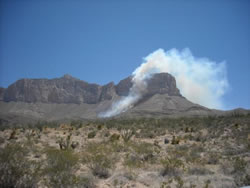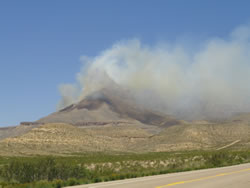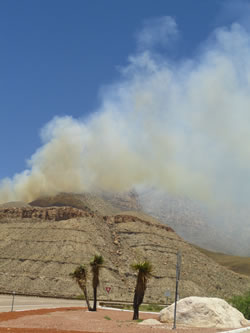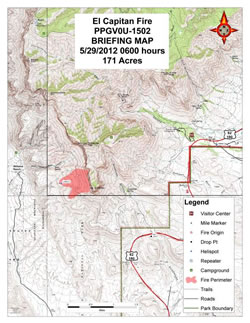National Cohesive Wildland Fire Management Strategy Success Story
Efficient Response to El Capitan Fire
Guadalupe Mountains National Park, Texas
Cohesive Strategy - Response to Wildfire
2012

El Capitan Fire. NPS / Christie La Paz.

El Capitan Fire. Photos by Judy Norman.

El Capitan Fire. Photos by Judy Norman.
The lightning-ignited El Capitan Fire was detected in Guadalupe Mountains National Park on May 26, 2012. The fire was located on the west side of El Capitan Peak, approximately one mile east of historic Williams Ranch and approximately three miles southwest of Pine Springs, Texas. Fuels included yucca/sotol, cacti, brush and grass in steep, rugged terrain. Red flag conditions, terrain, and fuels added to the potential for rapid wildfire spread.
The Pecos Zone Type III Incident Management Team (Incident Commander Northcott) assumed command of the El Capitan Fire on May 28. Resources assigned to the fire included crews from California and crews from the nearby vicinity, including the Los Diablos Type 2 Initial Attack Crew comprised of Mexican National firefighters, park staff from Big Bend National Park and Carlsbad Caverns National Park.
Engines assigned to the fire included the Boles Acres Fire Department, the Chihuahua Engine from Ruidoso, the Truman and Eagles Engines from Mescalero, American Wildfire in Capitan, and Shiloh Wildfire Services in Carlsbad, all from New Mexico.
A Type 3 Helicopter from BIA Mescalero Agency also flew logistical and reconnaissance missions in support of firefighters on the ground.
The fire team and resources quickly mobilized and worked effectively and efficiently to contain the fire in just three days at approximately 171 acres. No structures were damaged or destroyed. Defensible space work conducted in the Pine Springs area and in the Pine Springs Campground during the El Capitan Fire will also help protect structures from future wildfires in the area.
“We are grateful to the Pecos Zone III Incident Management Team, an interagency team, and all of the crews, engines and support staff for their hard work and professionalism in suppressing the El Capitan Fire. They were a great example of cooperation and coordination between agencies. Their actions prevented the fire from spreading around El Capitan into Guadalupe Pass and Pine Springs, preventing damage to the Pine Springs Visitor Center and Campground, the park housing area and Texas Department of Transportation housing area and other structures” said Dennis A. Vásquez, Guadalupe Mountains National Park Superintendent. “ All of the crews that worked on this fire worked under very rough conditions with very steep, rugged terrain, high heat, dryness and wind, along with desert flora – yuccas, sotols and a variety of cacti - all around. Because of their experience, training and professionalism, there were no accidents or injuries to personnel working on the fire or to visitors throughout the entire fire.”
Contact: John Montoya, Fire Management Officer, John_Montoya@nps.gov, (915) 828 - 3251 ext. 2801.
Keywords: Cost Effectiveness and Efficiencies, Mobilization
